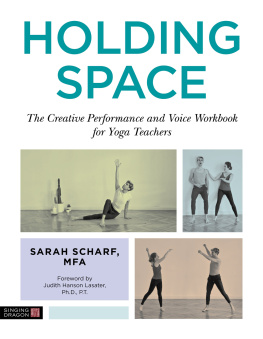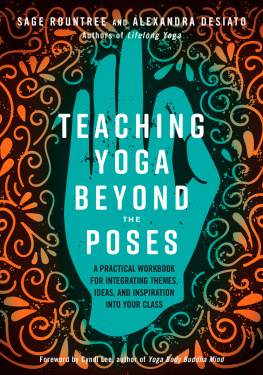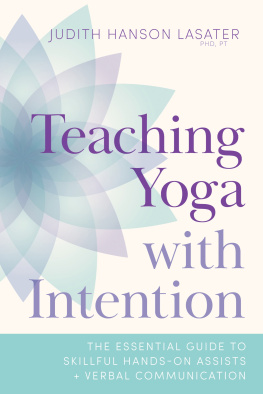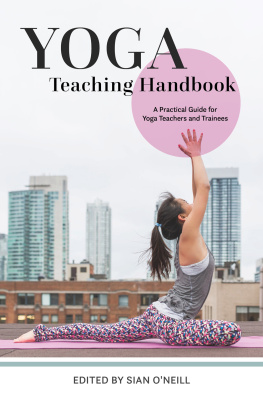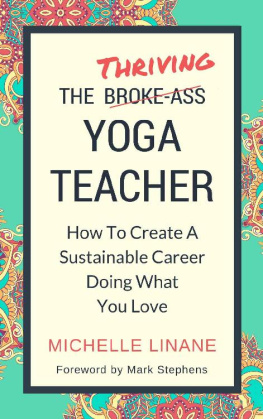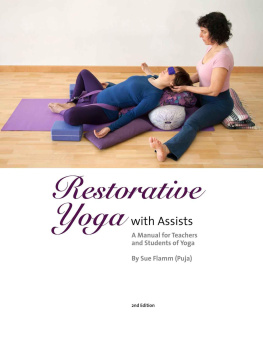Contents

HOLDING
SPACE
The Creative Performance and
Voice Workbook for Yoga Teachers
SARAH SCHARF, MFA
Foreword by Judith Hanson Lasater, Ph.D., P.T.

Contents
Foreword
Teaching yoga is not just about what you know. It is actually more about how well you are able to communicate what you know, so that the student takes in your words and understands them deeply in his or her own body and mind.
Sarah Scharf has written a comprehensive book to help us all investigate how to do this. In Holding Space she has taken us on a step-by-step investigation into how the words, tone, volume, as well as the intention of our speech, meld together to create communication.
She also offers us some asana practice and self-reflective suggestions and exercises that help us to prepare the vessel from which our voice emanates.
Sarah is in a unique position to write such a book. She has an extensive background in both yoga and theater, both of which are first and foremost about communicating. I first met her in my yoga class, and to say she was enthusiastic and curious about the restorative yoga I was teaching is an understatement.
She soon started showing up in my workshops at various places around the world, and we gradually became colleagues, and finally friends as well. Her bright demeanor and infectious laugh have made her easy to work with over the years as she began to assist me.
I am grateful to her for this book. Teaching is primarily a relationship: first we need to have a clear relationship with ourselves. And then we are better prepared to have a healthy relationship with our students. The basis of all relationships is, of course, the ability and willingness to communicate. Most yoga teacher training programs with which I am familiar teach their trainees what to say , but not how to communicate . Sarah teaches us the difference, and opens our eyes and ears to how we might improve our skills to allow for complete communication. She teaches us this in a way that is integrated and clear.
Thank you, Sarah, for your passion for learning, and as well for your dedication to helping us all to be the best teachers we can be by offering us this book.
Judith Hanson Lasater , Ph.D., P.T., cofounder of Yoga Journal and
The California Yoga Teachers Association, author and master teacher
INTRODUCTION
For every existing yoga teacher, there are two more yoga teachers currently in training. As yoga grows in popularity so does the need for quality teaching. No matter what style of yoga you teach, chances are your training focused on the practices, anatomy and practicalities of starting to work. Most teacher trainings today are a standard 200-hour model, which is only enough time to introduce how to safely teach group classes and understand the how and why of what you teach. Its possible to touch on the importance of using your voice and presence to teach. Maybe some time is spent on how to create an environment in your classes that promotes inclusion, welcoming and authenticity. Rarely, however, is time spent on this topic in a thorough way that actually leaves you with a strong skill set. Many trainings end with a practice teaching session, after which you will be lucky to receive feedback on your teaching. This might be the only time you get this kind of constructive criticism from experts helping you grow as a teacher. Most feedback for new teachers includes improving the voice, dealing with nerves and connecting more with the group of people being taught. Then new graduates are sent off to figure out how to do that on their own.
Many teachers hear this feedback and then find few options on learning how to actually make it happen. Searching online or in guidebooks for yoga teacher improvement, I found more of the sameinstructions to speak loudly enough for the students in the back to hear you, with no tools on how to safely make that happen. In my research I also saw many notes on avoiding a yoga teacher voice but again nothing on what steps to take, or even what a yoga teacher voice is! This book is a guide to effective voice work and stage presence for yoga teachers.
Wherever you are in your path as a teacher, working on your voice and presence will make you a better teacher. It is another element of yourself to explore and build awareness. The better you know your own voice and your comfort level with speaking to large groups, the better you can teach and expand your edges.
Voice work is its own practice. Just as a yoga practice grows day by day, learning to improve your voice and presence as the teacher grows one step at a time. When we approach a complex yoga posture, we know it will take time to develop the component parts of breath, physical ability and mental focus. To an inexperienced yogi these poses can seem overwhelming or mysterious. It is the same with voice and presencewe must understand the component parts of how best to use our voices and be present as the teacher. It is not a mystery and it is not a gift from birth. It is a skill that can be learned and practiced. This book will teach you how.
WHY THIS BOOK?
I was a performer from a young age. I loved being the center of attention and spent most of my time making up plays and dances, rehearsing physical gestures endlessly to get it just right. My mother was a schoolteacher and a singer. She has a rich singing voice and a speaking voice that commanded attention. As much as I loved performing, I was told early on that my singing voice was not so good and I always thought of my other family members as the musical ones, constantly comparing my voice with my mothers. It never seemed to measure up.
As a speaker I had many opportunities to grow. I remember winning a poetry competition and reading my poem at the governors office when I was eight years old, school theater productions and acting classes where I worked on being heard. I remember my Bat Mitzvah, singing and leading the Saturday morning prayer service and delivering a speech at 13 to over one hundred people. By 17 I was teaching theater and dance to children, where I learned quickly to use my voice to keep the room in control and the kids from going wild. Looking back at my childhood, I see the story of my voice and how I learned to be comfortable in front of an audience, as myself not just as an actor.
Studying acting, directing and playwriting, I continued to learn the tools I use today as a yoga teacher. When I began to train as a yoga teacher and eventually teach I was lucky to have a background that gave me a platform to teach from. I continue to be inspired by my work in theater to explore the essence of communication and the complexity of human nature. This informs my yoga teaching and allows me to work like a director to mentor and help teachers develop their own power and confidence in vocal work. Coaching teachers on how best to use their voices and helping them recognize their own vocal histories is a joy and an honor for me. I want to elevate the standard of teaching in the yoga world and help teachers develop their potential to speak in an embodied way that connects the philosophy of yoga to the act of standing in front of a room of students and saying clearly, Lets begin.
HOW I FOUND YOGA
When I was 19 I trained to become a massage therapist. As a freshman at university my back had spasmed from stress and my first professional massage was a life-changing experience. Imagining all the people I could help, I also thought it would be a good side job while I tried to find work as an actress. At that time I had never heard of Reiki, practiced yoga only sporadically and was intent on pursuing an Academy Award. I spent a lot of my time going to parties and focusing on my social life, which was of course very dramatic. Learning about anatomy and studying the human body was fascinating and I happily aced my massage certification exams. To complete the diploma required me to work more than 50 hours in the student clinic, which gave discounted massages to the community as a way of training the graduates. During my course with fellow trainees and working on friends to practice the techniques had been very easy for me. When the time came to work with the public, I was not prepared for the myriad of emotions that came up. At one point I started a session by placing my hands slowly on the clients back, which was covered by a cotton sheet. When my hands made contact with their back, I felt a wave of heat travel up my arms and I began to cry quite intensely. I had never experienced anything like this before and it scared me. I excused myself and got one of the teachers who was supervising the clinic to step in for me. After the client left my teacher suggested that I practice Reiki, a healing technique based on the Japanese theory of channeling universal energy. She recommended that I use Reiki to help me keep my energetic boundaries fortified and explained what an empath is. I was so overwhelmed by this experience and daunted by the idea that I would need to change my partying lifestyle that I quit the clinic and with only four hours left to complete my certification I gave up.

